
|
|
84%
Abstract: Thermalfly are a new heatsink manufacturer out of Taiwan, and the company is introducing itself with a collection of fresh thermal solutions.
|
Home >
Reviews >
Page: 360° View - Thermalfly F1-IACSHA Heatsink
|
360° View - Thermalfly F1-IACSHA
Heatsink
Information on Frostytech's test
methodology is available
here. | |
|
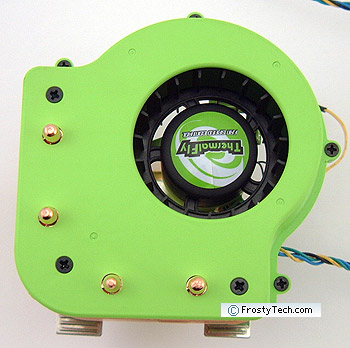 |
The Heatsink Fan:
The Thermalfly F1-IACSHA heatsink is built with a
63mm squirrel cage fan that spins at speeds of 1300-3500RPM. The fan speed is controlled either manually,
by a temperature responsive thermocouple located on top of the copper based block,
or via PWM in the BIOS. Air is drawn in from the top and
bottom of the heatsink, then expelled laterally out through the L-shaped array
of copper cooling fins. This design is more commonly
used on videocards, and so far this adaptation is unique to Thermalfly. The heatsink
measures 107mm x 107mm so it's important not to have any other
components that stand too tall next to the CPU socket.
Its four 6mm diameter copper heatpipes extend through the copper cooling fins
down to the copper base block. All joints are soldered. The fan is PWM compliant,
and a separate fan speed controller is included with the heatsink to allow manual control. |
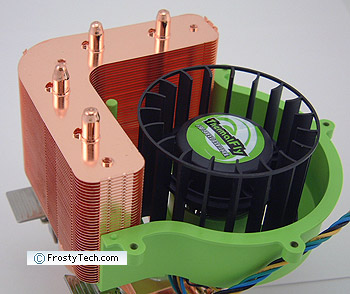 |
Heatsink
Top:
With the upper half of the green plastic fan shroud removed, the unique
construction of the Thermalfly F1-IACSHA heatsink is clearly visible. A benefit of the squirrel cage
fan design is that air is expelled
without any dead spots, as opposed to the traditional vaneaxial fan which has no airflow
directly behind its motor. The L-shaped section of copper cooling fins measures 23mm thick, 46mm tall.
The directionality of this design can be used to exhaust warm air towards the rear of the PC case. There,case
vents and the power supply will expel it from system quickly. |
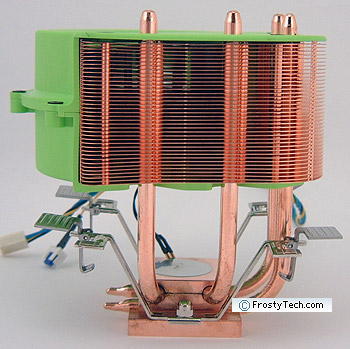 |
Heatsink Rear:
The Thermalfly
F1-IACSHA heatsink stands 107mm tall, and is elevated 37mm
above the base block for clearance of adjacent capacitors, northbridge
heatsinks, etc. The four copper heat pipes are positioned to one
side of the heatsink, and intersect with the base at right angles in
an overlapping fashion. Each copper cooling fin is 0.3mm thick
and spaced 1.0mm apart. The stainless steel mounting clips attach to a
supplied heatsink retention frame that accomodates both socket 775 and
K8 socket 939 platforms. The rear
motherboard support brackets use non-standard metric threading (in the K8 case at least) so
the user will need to remove the motherboard to install either one. On
top of the copper base block you can see a thermocouple
which has been attached with a metallized sticker. This sensor controls the fan speed,
based on the temperature it records (ranging from 1300 to 3500 RPM). |
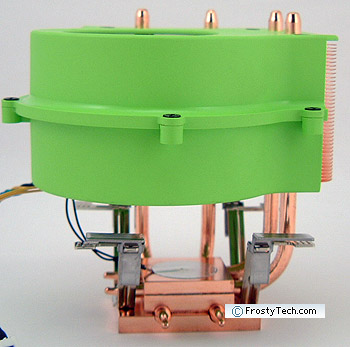 |
Heatsink Side A:
The copper base block directly in contact with
the CPU's integrated heatspreader measures 6 mm thick. Above this are two
additional copper blocks which interface with the
four 6mm diameter copper heat pipes; these are 12 mm thick in total. All
copper joints are soldered for the lowest possible thermal resistance. One of the unique things about
the Thermalfly F1-IACSHA heatsink if that air is drawn into the PWM squirrel cage fan from the top
and bottom of the heatsink. As that air picks up heat from the copper cooling fins it quickly exits
the heatsink laterally. |
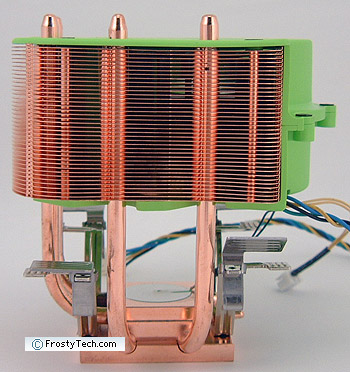 |
Heatsink Side B:
Another profile of the Thermalfly
F1-IACSHA heatsink to illustrate how the heatsink is configured.
All cooling fins are located along one half of the cooler only. The upper
portion of the heatsink measures 107 mm across. stainless steel mounting clips hook onto the heatsink retention mechanism in fashion similar
to older socket 478 heatsink's. |
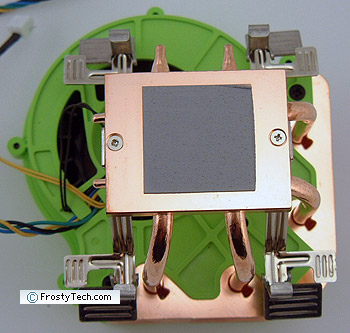 |
Heatsink Base:
The copper base of the Thermalfly
F1-IACSHA heatsink is 52 mm long, 41 mm wide; making it compatible
with both Intel and AMD processor IHS sizes. The heatsink ships with thin grey pad of ShinEtsu X-23-7762 thermal interface material evenly applied.
The copper is machined pretty flat, and is smooth. Surface roughness is on
the order of ~12 microinches, which is considered excellent. For the purposes of
a Frostytech's tests, the thermal interface material was removed and a standard amount
of white silicone grease applied. |
|
 |
Websites you may also like:
PCSTATS
|
|
 |


